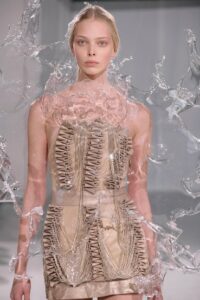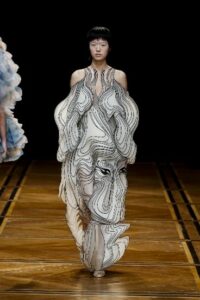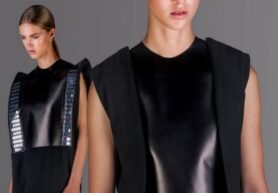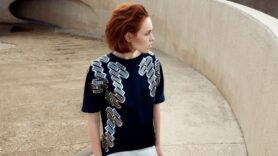Fashion of the Future
The hidden world behind fashion
By Stijn Alberts, November 2021
Special nanotechnology interwoven into your clothes, or clothes made from fungi. These are both examples of how technology influences fashion. Technology creates new ways to create the clothes and adds new functions to it as well. But while it seems new technologies only add to what fashion has to offer; their implementation also has some restrictions. In this article we are going to explore what affects the fashion design process from the perspective of two different fashion designers, ending with why this should matter to you too.
 The first fashion designer is Iris van Herpen. A Dutch fashion designer who was the first to make use of the 3D printer and was therefore a frontrunner in using technology in fashion. For her, it seems, aesthetics is very important. Her designs may sometimes represent phenomena one would not expect to see in fashion. In the picture on the left, you can see an example of one of these phenomena, wherein a dress is also a splash of water. This water was created using a 3D-printer.
The first fashion designer is Iris van Herpen. A Dutch fashion designer who was the first to make use of the 3D printer and was therefore a frontrunner in using technology in fashion. For her, it seems, aesthetics is very important. Her designs may sometimes represent phenomena one would not expect to see in fashion. In the picture on the left, you can see an example of one of these phenomena, wherein a dress is also a splash of water. This water was created using a 3D-printer. Even though this dress was first created in 2011, you cannot buy this dress yourself. Three reasons can be given for this: firstly, it is very expensive to produce. Secondly, this dress was created merely for the catwalk. Thirdly, this dress would probably be extremely uncomfortable. 3D-printed items are often very hard and therefore quite uncomfortable. As such, even if you could buy it, you would probably never wear it to any party whatsoever.
Even though this dress was first created in 2011, you cannot buy this dress yourself. Three reasons can be given for this: firstly, it is very expensive to produce. Secondly, this dress was created merely for the catwalk. Thirdly, this dress would probably be extremely uncomfortable. 3D-printed items are often very hard and therefore quite uncomfortable. As such, even if you could buy it, you would probably never wear it to any party whatsoever.
She does have other designs that are more comfortable and are still as gorgeous if not more and do not have this uncomfortable aspect. One of these designs can be seen on the right. This dress was not made with 3D printing, but instead was made with mostly laborious traditional techniques. The design, however, could have never been made without the use of a computer.
Van Herpen shows us a lot of new expressions fashion may be able to offer us in the future. She shows the possible variety fashion may have and the choices our future selves may face in the morning.
Another fashion designer that does a lot with new technologies is Pauline van Dongen, also a Dutch fashion designer. Besides being a fashion designer, she has also finished a PhD at the university of Twente on the interactions between technology and fashion. Whereas Iris van Herpen looks a lot at the aesthetics of her designs, Pauline van Dongen is working a lot more on how her designs would relate to you. During her PhD she designed a dress and a T-shirt, both with the ability to absorb the sunlight and create electricity to for example charge your phone, using solar cells.
 Van Dongen’s dress was designed first. A picture of it can be seen on the left. It consists of two rows of solar cells over the shoulder that can be hidden by folding the fabric over. Also, a USB cable which can be used to charge your phone is hidden in a pocket. Because of the dark colour of the solar cells, she decided to make the dress dark too. Since the solar cells were quite fragile, she had them installed on less flexible leather. This shows ways the technology put restrictions on the design; the dark color of the cells was unchangeable, and the fragility of the cells had to be kept in mind.
Van Dongen’s dress was designed first. A picture of it can be seen on the left. It consists of two rows of solar cells over the shoulder that can be hidden by folding the fabric over. Also, a USB cable which can be used to charge your phone is hidden in a pocket. Because of the dark colour of the solar cells, she decided to make the dress dark too. Since the solar cells were quite fragile, she had them installed on less flexible leather. This shows ways the technology put restrictions on the design; the dark color of the cells was unchangeable, and the fragility of the cells had to be kept in mind.
Something else noteworthy also happened: The behaviour of the people wearing the dress was noticably influenced. The wearers were actively aware of the fragility of the solar cells while wearing the dress, causing them to be more careful while walking around in it. On top of that, the wearers became more aware of their environment because they got more careful.
Then there were the some extra problems too: the rigid leather used to protect the cells, also limited the movement of the wearers. On top of that, the dress, with all its technology, was quite heavy. Lastly, the dress was very expensive to produce.
 After the dress she designed the T-shirt (which can be seen on the right). For this second design, she took the opportunity to tackle a few of the problems associated with the dress design. For starters, a different technique was used to add the cells to the design: the cells were printed on the shirt. This also meant the cells stood out more, but it made the shirt production easier to mass produce and more flexible. Because the cells were more flexible, less heavy and rigid materials could be used, making the shirt more comfortable than the dress. The shirt was, however, still relatively heavy, because of all the circuitry as well as a battery built in it.
After the dress she designed the T-shirt (which can be seen on the right). For this second design, she took the opportunity to tackle a few of the problems associated with the dress design. For starters, a different technique was used to add the cells to the design: the cells were printed on the shirt. This also meant the cells stood out more, but it made the shirt production easier to mass produce and more flexible. Because the cells were more flexible, less heavy and rigid materials could be used, making the shirt more comfortable than the dress. The shirt was, however, still relatively heavy, because of all the circuitry as well as a battery built in it.
While wearing the shirt herself, Van Dongen noticed something special: she wanted to go out more and was more inclined to walk in the sun. She became more mindful of her direct environment. Also, the exposed cells attracted attention from curious bystanders. This was of course nice for her, since she could show off what she had made, but it is less desirable for someone who just wants to just get from place A to place B while charging their phone.
It has been known for quite a while that our clothing influences the way we think and act. An early example of this was in 1998, when researchers found that women wearing swimsuits would eat less and perform worse at maths. This was thought to be related to the objectification of women in our culture at the time. In 2012, the effect of changing the way you think and act based on what you wear was given the name Enclothed Cognition.
Van Dongen has experienced this enclothed cognition first-hand. This shows that technological developments in fashion may eventually also change your behaviour. Van Dongen is also actively researching how her designs would affect the wearer. Talking about the implementation of technology in fashion, she explicitly says that using technology as a gimmick is one of the largest pitfalls of technology. She wants us to feel in control of the technology, but she also wants to stimulate our own consciousness. As such, you can say that she is looking for ways she can use clothing to actively influence us all for the better.
Van Herpen does not explicitly search for ways to influence the wearers. Instead, she looks at what she can create from different materials, often resulting in Beautiful, otherworldly designs. If her designs could ever be affordable and comfortable, they may very well be the big new thing. This leaver to wonder, however, how would we behave and think wearing something so alien?
Sources:
• Adam, H. and Galinsky, A. D. “Enclothed Cognition.” Journal of Experimental Social Psychology 48 (2012): 918-925. https://doi.org/10.1016/j.jesp.2012.02.008.
• Van Dongen, P., Wakkary, R., Tomico, O., and Wensveen, S. “Towards a Postphenomenological Approach to Wearable Technology through Design Journeys.” Textile intersections, September 12-14, 2019. https://www.paulinevandongen.nl/portfolio/conference-paper/.
• Fredrickson, B. L.; Roberts, T., Noll, S. M., Quinn, D. M., and Twenge, J. M. “That swimsuit becomes you: Sex differences in self-objectification, restrained eating and math performance.” Journal of Personality and Social Psychology 75, no. 1 (1998): 269-284. https://doi.org/10.1037/0022-3514.75.1.269.
• Pleij, Sander. “MENS #4: Pauline van Dongen”. MENS. Podcast Audio, Aug., 2019. https://www.vn.nl/mens-4-pauline-van-dongen/.
• Smelik, A. “Fractal Folds: The Posthuman Fashion of Iris van Herpen.” Fashion Theory (2020): 1-22. https://doi.org/10.1080/1362704X.2020.1850035.
• Smelik, A., Toussaint, L., and van Dongen, P. “Solar Fashion: An embodied approach to wearable technology.” International Journal of Fashion Studies 3, no. 2 (2016): 287-303. https://doi.org/10.1386/infs.3.2.287_1.
• Stol, Ingelou. “High Tech Podcast #11 – Is technologie de sleutel om de mode-industrie te verduurzamen?”. High Tech Campus Eindhoven. Podcast audio, 2020. https://soundcloud.com/user-935346156/high-tech-podcast-is-technologie-de-sleutel-om-de-mode-industrie-te-verduurzamen.
Image sources:
• Thumbnail: Zichuan Han. https://www.pexels.com/nl-nl/foto/persoon-in-zwarte-top-in-oranje-verlichte-kamer-1719233/
• First image (left): Iris van Herpen. Capriole, Look 17. https://www.irisvanherpen.com/collections/capriole/runway-17.
• Second image (right): Iris van Herpen. Shift Souls, Look 15. https://www.irisvanherpen.com/collections/shift-souls/runway-6.
• Third image (left): Pauline van Dongen. Solar Dress. Photograph by Mike Nicolaassen. https://www.paulinevandongen.nl/portfolio/wearable-solar-dress/.
• Fourth image (right): Pauline van Dongen. Solar Shirt. Photograph by Liselotte Fleur. https://liselottefleur.com/gallery/pauline-van-dongen/.

